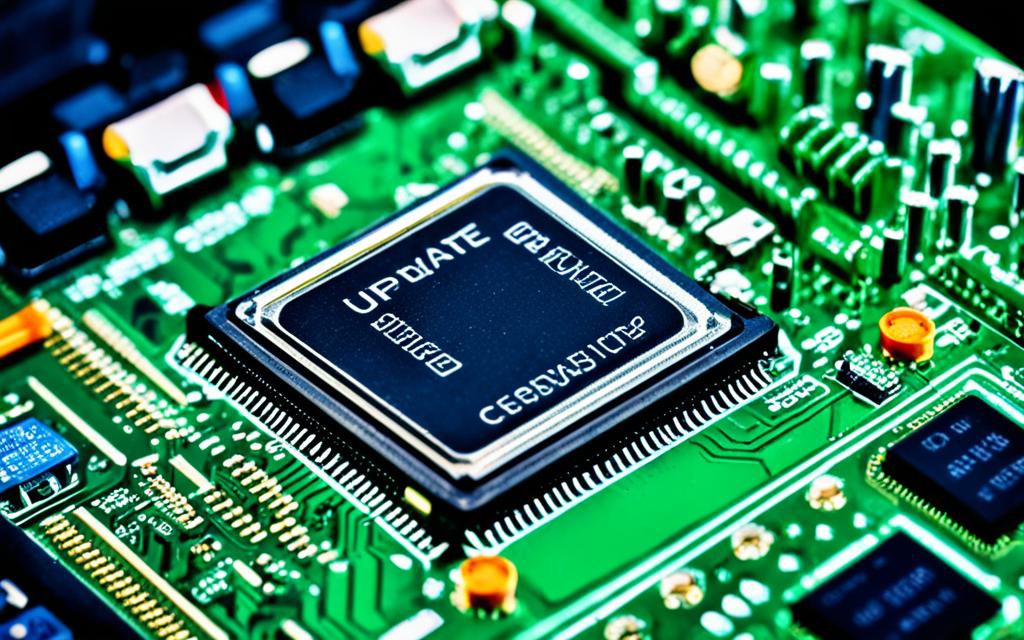How to Update the Motherboard Drivers: Easy Guide
If you want your computer to run well, keeping your motherboard drivers updated is key. This guide will help you update the motherboard driver, add the newest motherboard BIOS, and solve any motherboard driver compatibility problems. We’ll explain why it’s crucial to keep your motherboard chipset drivers current. Also, we’ll show you how to get the latest motherboard manufacturer drivers and fix basic motherboard driver troubleshooting issues.
By the time you finish reading, you’ll know just how to handle your computer’s motherboard driver requirements. You’ll be able to keep your system working smoothly.
Introduction to Motherboard Drivers
Motherboard drivers are essential for your computer to work well. They help the hardware talk to the software. This way, everything in your computer can work together smoothly.
What are Motherboard Drivers?
These are programs that make your motherboard and operating system work as a team. They connect your CPU, RAM, and other parts to your system. This connection lets your computer function properly.
Importance of Keeping Drivers Up-to-Date
It’s crucial to update your motherboard drivers. This keeps your system running smoothly and safely. New updates fix problems and make your computer more secure against attacks.
By keeping your motherboard drivers up-to-date, your computer can work with the latest programs and devices. You would also notice better performance. Updated drivers make your computer more reliable and less likely to have issues.
Regularly updating your motherboard drivers makes your system better. It helps avoid problems and keeps your computer safe. So, always update when you can.
Identifying Your Motherboard Model
Before updating your motherboard drivers, knowing your model is key. This helps find the right drivers. Luckily, finding your model is not too hard.
To start, you can check your computer’s BIOS. Look for a screen that shows your hardware details when you turn on your computer. You can get to the BIOS by pressing keys like Delete or F2. This is usually during startup.
Another way is through the Windows Device Manager. Go there, find “System Motherboard” under “System devices,” then see the model information by clicking “Properties.”
If you like hands-on ways, looking at your motherboard directly works too. Take off your computer’s case and find the model number on a sticker or label.
Once you know the model, visit the manufacturer’s website. There, download the latest drivers for your motherboard. This ensures your system runs smoothly and avoids any issues with compatibility.
| Method | Description |
|---|---|
| BIOS | Check the motherboard model information displayed during the boot process |
| Device Manager | Expand the “System devices” section and look for the motherboard entry |
| Physical Label | Locate the sticker or label on the motherboard itself |
How to Update the Motherboard Drivers
It’s important to keep your motherboard drivers up-to-date for the best performance. Luckily, updating them is easy. You can use the Windows Update feature or get them from the manufacturer’s website directly.
Updating Drivers through Windows Update
The Windows Update option is handy for this task. With Windows 10 and 11, your system is checked for the latest drivers. Here’s how to do it:
- Open the Start menu and look for “Windows Update settings”.
- Click on “Check for updates” to start the scan.
- Windows will install any new motherboard driver updates it finds.
This approach is simple and quick. Yet, not all motherboard drivers may be updated this way. In some cases, you’ll have to get the drivers from the manufacturer’s site instead.
Downloading Drivers from the Manufacturer’s Website
To get the most recent motherboard drivers, head to the maker’s website. Follow these steps:
- Find your motherboard’s model, usually on the board or in your specs.
- Go to the manufacturer’s site and find the support or downloads section.
- Find your specific model and download the newest driver package.
- Install these downloaded drivers by following what’s on the screen.
Getting drivers from the maker’s site ensures your system has the right and newest drivers. This helps with performance and avoids compatibility problems.
Using the tips above, you can easily update your motherboard drivers. This keeps your system in top shape. Remember, keeping your drivers current is key to your computer’s health and speed.
Troubleshooting Common Driver Update Issues
Updating your motherboard drivers is key to keeping your computer running well. But sometimes, you might face problems like conflicting drivers or issues with new updates. We’ll show you how to work through these issues and update your drivers smoothly.
Resolving Driver Conflicts
If two drivers fight for the same resource or if a new driver messes with an existing one, you have a conflict. Here’s what to do:
- Open the Device Manager by right-clicking on the Start menu and selecting “Device Manager”.
- Look for any devices with a yellow exclamation mark or a red X, which indicates a driver issue.
- Right-click on the conflicting device and select “Update driver” or “Uninstall device”.
- If the issue persists, try uninstalling the problematic driver and reinstalling it or updating it to the latest version.
Handling Driver Compatibility Problems
Sometimes, a new driver simply doesn’t fit well with your computer. To tackle this, try:
- Make sure you’re getting the right driver for your motherboard and operating system.
- Check the manufacturer’s website for any driver compatibility info or known issues.
- Roll back to the earlier driver if needed.
- If all else fails, a system restore point can take your system back to how it was before the update.
By using these steps, you can fix common motherboard driver update issues, deal with conflicts, and solve compatibility issues. This will make updating your drivers a breeze.
Benefits of Updating Motherboard Drivers
Updating your motherboard drivers often brings big advantages. Your computer will perform better and be more reliable. This helps improve your experience while using your computer.
Keeping drivers up-to-date means improved system compatibility. New software and hardware need updated drivers to work well with your motherboard. By updating, your system can avoid issues and crashes.
Updated drivers also bring better system security. Old drivers might miss important security updates. Updating your drivers helps protect your computer from cyber threats.
Plus, up-to-date drivers make your system run smoother. They can speed up your computer and make it more stable. This leads to quicker startup times and a better overall performance.

In the end, updating your motherboard drivers is very beneficial. It improves system compatibility, security, and performance. This makes your computer experience more reliable and enjoyable.
Preparing for a Motherboard Driver Update
Before updating your motherboard drivers, take important precautions. Creating a system restore point is key. It can save you from a system meltdown if something goes wrong.
Creating a System Restore Point
It’s easy to make a system restore point for safety. Here’s what you need to do:
- Open the Start menu and search for “Create a restore point”.
- Click on the “System Properties” window that appears.
- In the “System Protection” tab, click the “Create” button.
- Give your restore point a descriptive name, such as “Pre-Motherboard Driver Update”.
- Click “Create” to generate the restore point.
Creating a system restore point is crucial before updating your Pre-Motherboard Driver Update. It acts as a safety net. If problems come up, you can go back to how things were.
Taking time to create a system restore point before driver update is important. It’s a small step that can save you a lot of trouble. With this, you ensure your system is safe and ready for the update.
Motherboard Driver Update Best Practices
Updating your motherboard drivers right can be key. As pros, we’ve put together a guide for a smooth update process. Follow our tips to get all the benefits without the update worries.
- Backup Your System: It’s crucial to have a system restore point or back up your data. This step is a safety net if things don’t go as planned.
- Check Manufacturer’s Website: Go to the maker’s website for the newest and most fitting drivers. Avoid third-party sites. They might have old, wrong drivers.
- Uninstall Existing Drivers: If your driver is old, uninstall it first. This step avoids problems with the new driver.
- Perform a Clean Installation: A fresh driver install is often better than just an update. This way, the new driver starts fresh with your system.
- Reboot After Installation: After updating, always restart your computer. This step makes sure the new driver works well with your system.
- Check for Compatibility: Make sure the new drivers match your motherboard and OS. The wrong driver could harm your computer.
- Keep Backups: Always keep a backup of your system. This includes your motherboard drivers. You might need to go back to older versions.
Stick to these motherboard driver update tips for a smooth process. They help you use your system to its fullest. Keeping up with driver updates is crucial for top computer performance and stability.
Additional Tips and Resources
Keeping your motherboard drivers up to date is key for your computer’s top performance and stability. Besides the basic updates, some extra tips and resources can help with managing drivers better.
Recommended Tools for Driver Updates
- Driver Booster: This tool scans your system and updates drivers with just one click.
- DriverFix: It’s a more advanced program that tracks down any outdated or missing drivers for you.
- Windows Device Manager: You can also update, roll back, or uninstall drivers manually using the built-in Windows tool.
Online Forums and Communities
Along with the resources from the manufacturers, online forums and communities are great for support. They offer advice on motherboard driver updates. Here are a few:
- Tom’s Hardware Forums: This is a go-to place for tech issues and driver updates.
- Reddit’s /r/techsupport subreddit: Here, tech fans help each other with all kinds of computer problems.
- Manufacturer-specific forums: Make sure to check your motherboard’s maker site for direct help and updates.
Additional Resources
To learn more about updating your motherboard’s drivers, check out these extra resources:
| Resource | Description |
|---|---|
| PCWorld Guide: How to Update Drivers in Windows 10 | This is a detailed walkthrough on how to update drivers in Windows 10. |
| HowToGeek: How to Update Your Computer’s Drivers for Maximum Performance | It’s a guide that explains why driver updates are important and shares the best care practices for your computer. |
| CNET: How to Update Drivers in Windows 10 | This offers an easy-to-follow guide from a trusted tech site on updating drivers in Windows 10. |
Using these extra tips and resources, you’ll be able to update your motherboard drivers more smoothly. It helps troubleshoot issues and keeps your computer running at its best.
The Importance of Regular Driver Updates
It’s important to keep your motherboard drivers updated. This helps your computer run stably and smoothly. An up-to-date driver can make your computer work better.
Updating often ensures your computer can work with the newest software and devices well. As tech changes, your drivers must too. This ensures everything works together perfectly.
Keeping your drivers updated is vital for security too. Old drivers can make your computer open to attacks. New updates usually have security fixes to keep you safe.
Besides, newer drivers can make your computer faster and more efficient. They bring in updates that make things run smoother. Your computer might start up quicker, apps might run better, and it could save energy.
The Benefits of Keeping Drivers Up-to-Date
- Improved compatibility with the latest software and hardware
- Enhanced security through patched vulnerabilities
- Increased system performance and efficiency
- Reduced risk of driver-related crashes and errors
- Access to the latest features and functionality
Keep your drivers up-to-date to enjoy the best your system can offer. Regular updates ensure everything runs well together. This is key to a great and reliable computer experience.
| Benefits of Updating Drivers Frequently | Consequences of Outdated Drivers |
|---|---|
|
|
Conclusion
Updating your motherboard drivers regularly is key to keep your computer running well. This guide has shown you how to do it step by step. By following our advice, your computer will work better and you’ll be using the best driver versions.
We’ve laid out a detailed path for you. First, figure out which motherboard model you have. Then, download and install the right drivers. This will make sure everything works smoothly.
It’s important to stay on top of your driver updates. Doing so improves your computer’s performance and stops problems before they occur. With this knowledge, you can keep your system in top shape and avoid many issues.




